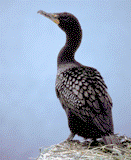United States Department of Agriculture, National Wildlife Research Center: Symposia

Symposium on Double-Crested Cormorants: Population Status and Management Issues in the Midwest
Date of this Version
December 1997
Abstract
Populations of double-crested cormorants (DCCO’s, Phalacrocorax auritus) have increased dramatically in North America during the past 2 decades (1978–98), especially in the Great Lakes region and Southeastern United States. Concern about the impact, real or imagined, of DCCO’s on economics and ecosystem health has risen in parallel to the increase in cormorant numbers. A daylong symposium on this subject was opened by Stephen Lewis and D. V. (Chip) Weseloh, who introduced the audience to the general problems associated with cormorants in the Midwest. The moderators identified the following symposium objectives: (1) to provide current information on the status and biology of the DCCO; (2) to review scientific evidence related to the impacts of cormorants on sport fish, aquaculture operations, vegetation, and other colonial waterbirds; (3) to discuss options available to resolve human–cormorant conflicts; (4) to identify information needs (monitoring and research) related to cormorant management; and (5) to enhance communication and coordination among all entities concerned about cormorants and the resources they potentially affect.

